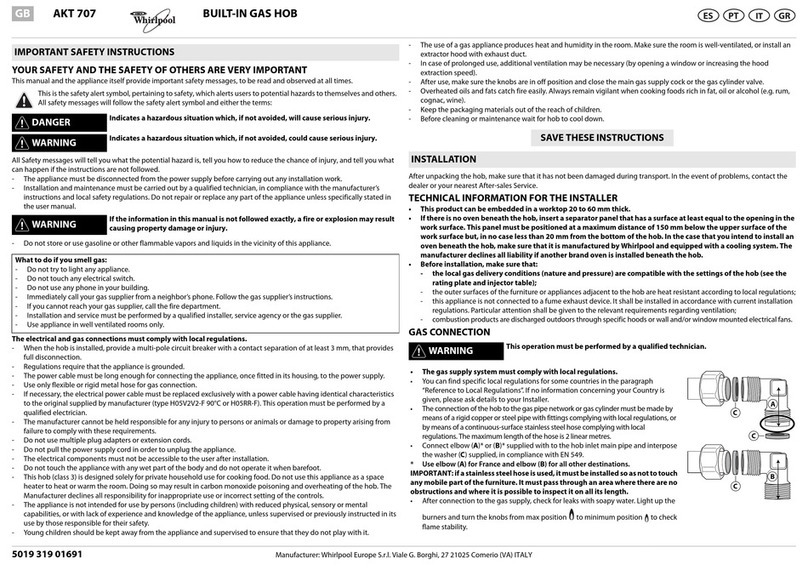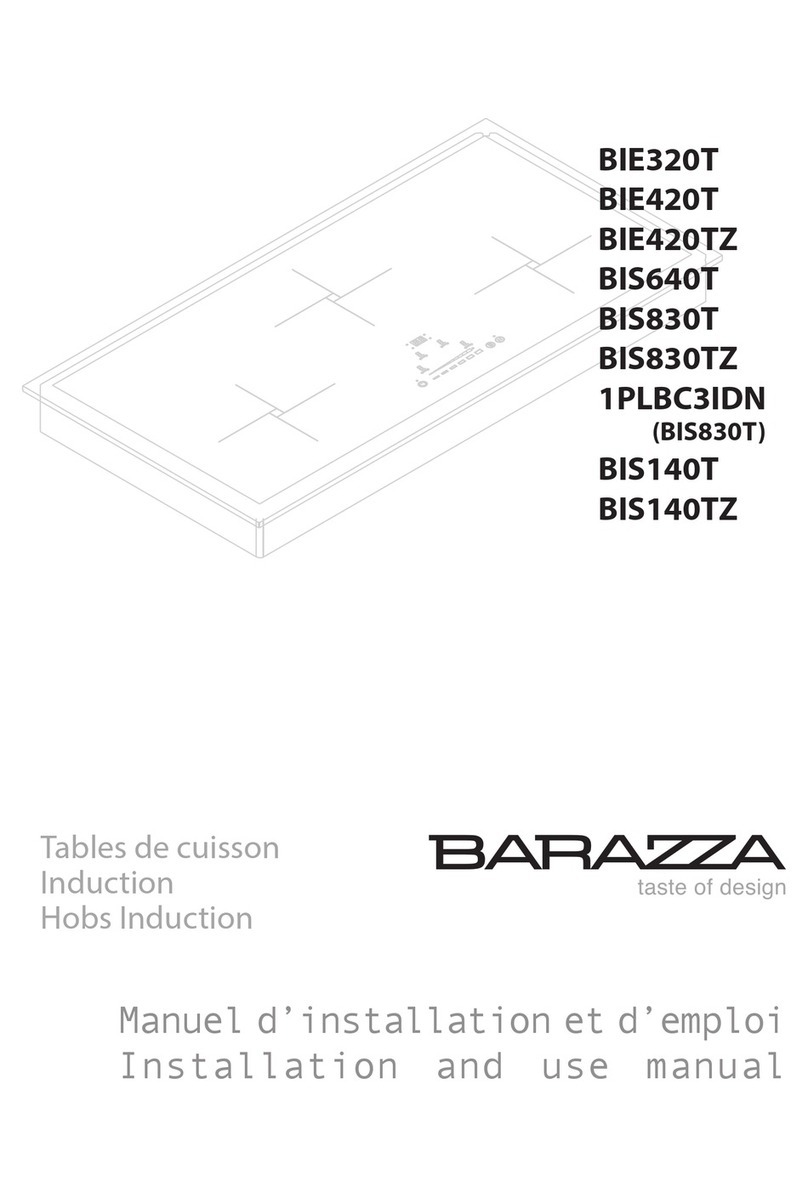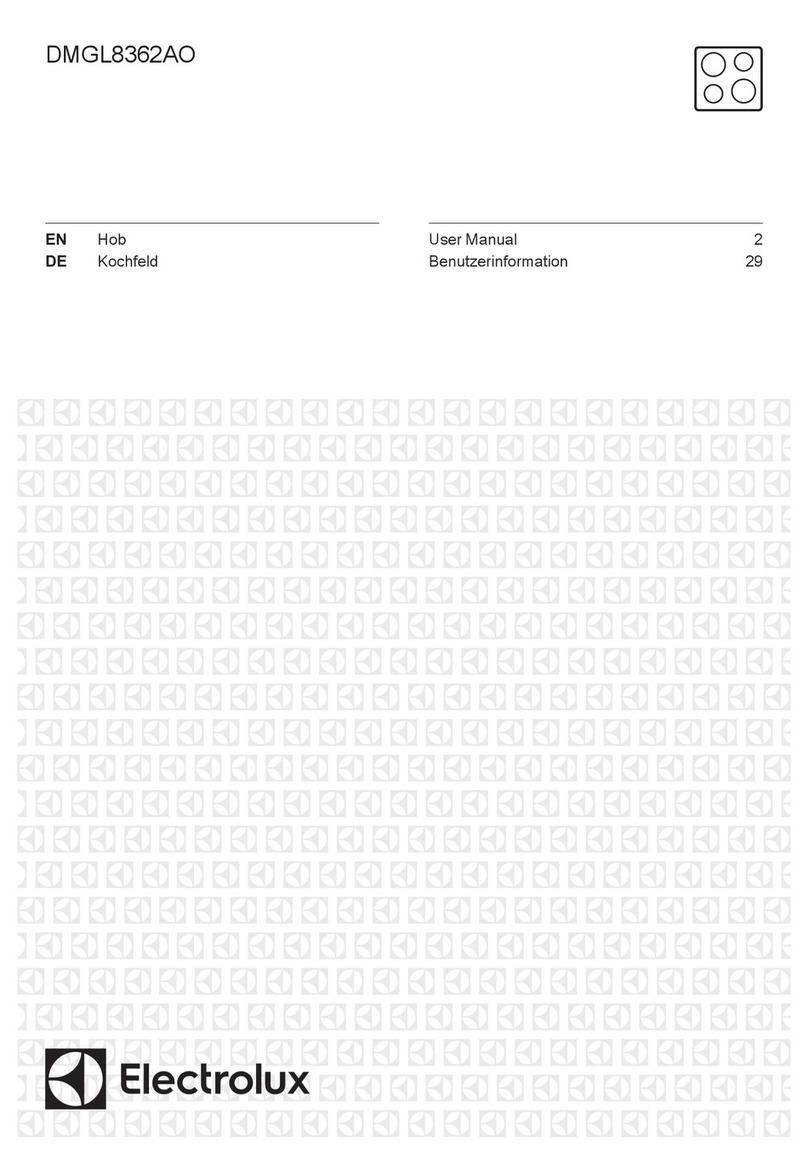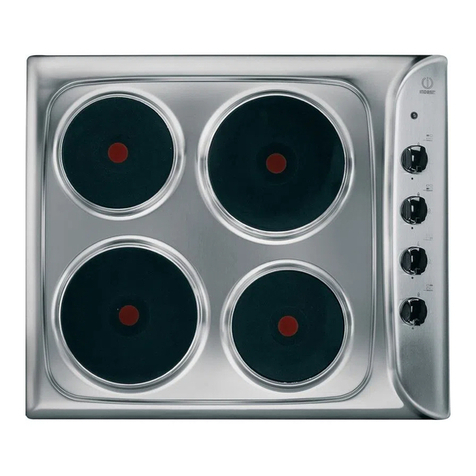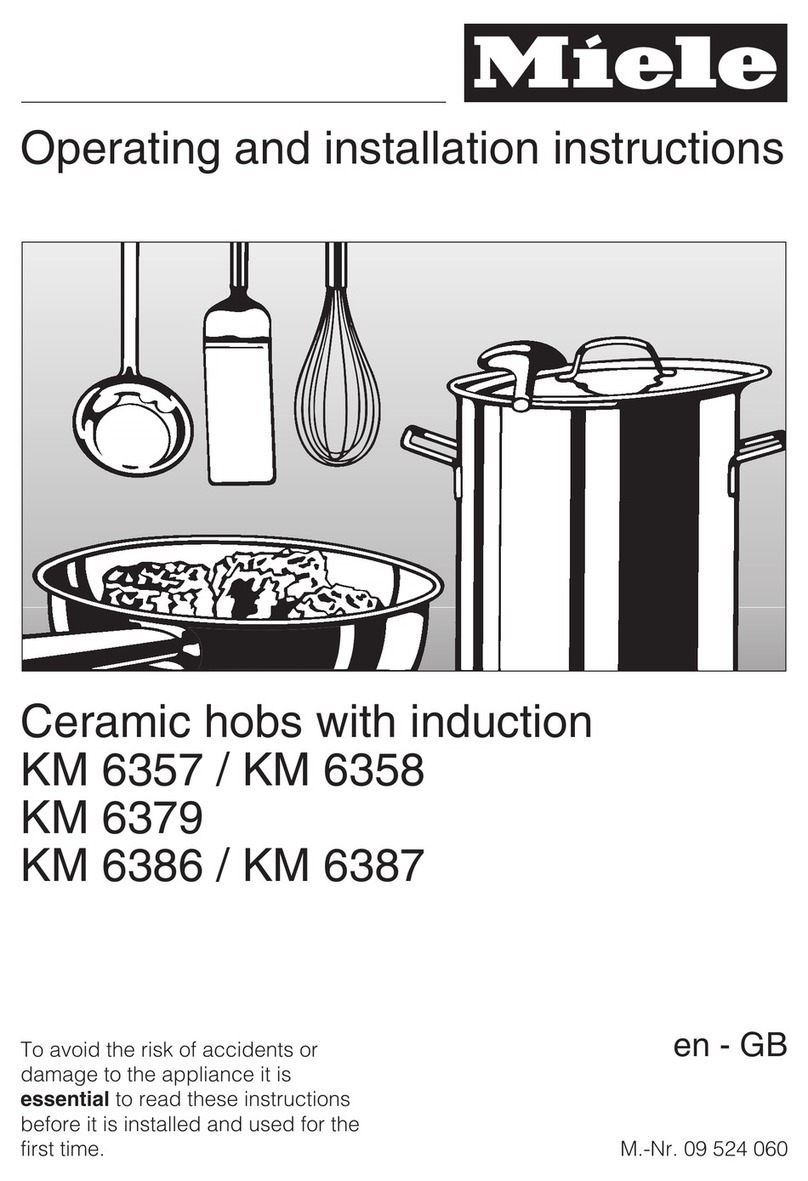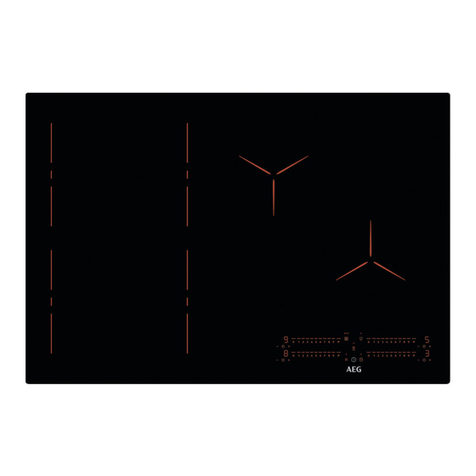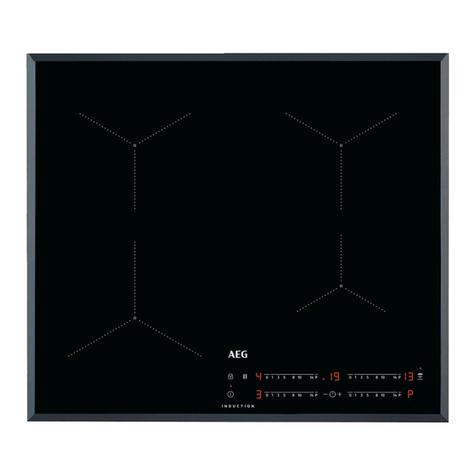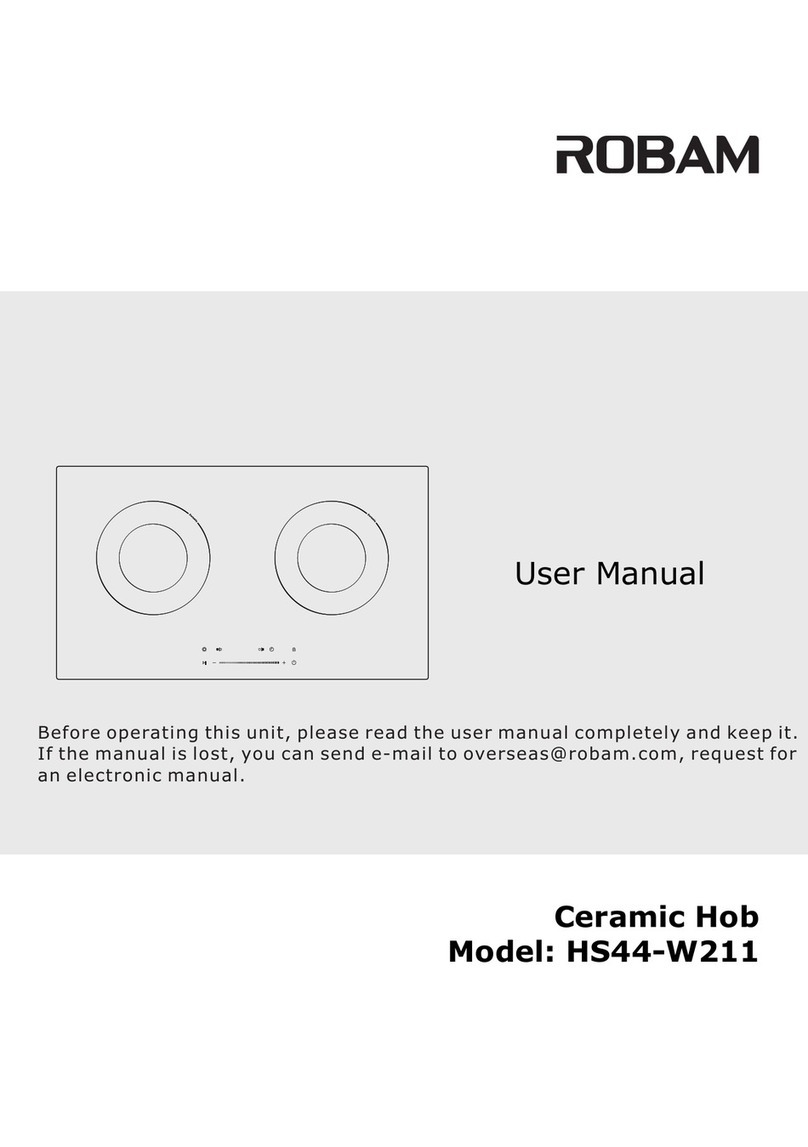Millar GH604 User manual

GB
!
!
!
!
!
Instruction Manual
For Built-In Gas Hobs
!
!
!
!
!
!
!
!
!
!
!
!
!
!
!
!
!
!
!
!
!
!
!
!
!
!
!
!
!
!
!
!
!
!
!
!
Millar Int’l Ltd
!
!
Address: 10 Hornby Street, Manchester
M8 8DQ
United Kingdom
!
!
info@millargb.com
www.millargb.com

1.
General Precaution..................................................................................................... 4
2.
Close-up view ..............................................................................................................5
2.
How to use your appliance......................................................................................... 6
3.
How to keep your cooktop in shape ..........................................................................7
4.
Practical advice ........................................................................................................... 8
5.
Troubleshooting .......................................................................................................... 9
6.
Health and Safety...................................................................................................... 10
7.
Installation instructions ...........................................................................................12
8.
Table 1: Burners and nozzle specifications ............................................................16
9.
Table 2: How to convert gas source ........................................................................17
10.
Table 3: Adapting to different types of gas…. ..................................................... 18
11.
Table 4: Gas source and national comparison table............................................20
11. NOTICE…. .............................................................................................................21

3
!
Congratulations on choosing Millar product.
We are confident that your new appliance, manufactured with top quality materials, will respond perfectly
your requirements.
Although you will find this appliance dependable and easy to use, we recommend that you read this manual
for best performance and to extend the life of your appliance.
Thank you.

4
!
General Precautions
!
!
!
Please read this instruction handbook carefully before installing and using the appliance.
This handbook must be kept in easy reach of the appliance for future consultation. If this appliance
is sold or transferred to another user, please give this handbook to the new user so that they can
learn how to use it correctly and be aware of the various warnings
This is a Class 3 appliance designed for home use.
-
This appliance complies with the following Directives:
73/23/EEC of 19/02/73 (Low Voltage) and subsequent modification;
-
89/336/EEC of 03/05/89 (Electromagnetic compatibility) and subsequent modifications;
-
90/396/EEC of 29/06/90 (Gas) and subsequent modifications;
-
93/68/EEC of 22/07/93 and subsequent modifications.
-
The appliance must be installed by a skilled and qualified installer, in conformity with statutory
legislation.
-
This appliance is designed for use by adults.
-
This appliance is not intended for use by persons (including children) with reduced or impaired
physical or mental capabilities, or persons lacking experience and awareness, unless they are
supervised or taught how to use the appliance by a responsible carer.
-
Do not allow children to play with the appliance.
-
Before powering the appliance, ensure that it is properly adjusted for the type of gas available
(see “installation”).
-
Before carrying out maintenance or cleaning operations, disconnect the appliance from the
power
supply and allow it to cool.
-
Ensure air is able to circulate around gas appliances. Insufficient ventilation will lead to
depletion
of the oxygen in the air in the place of installation.
-
In case of intense or prolonged use of the appliance, it may be necessary to increase ventilation,
for example by opening a window or increasing the power of extractor fans, if present.
-
Combustion products must be expelled from the place of installation through an extractor hood
or extractor fan (see “Installation”).
-
For any replacements or alterations that may be required, contact an authorised Technical
Assistance Centre and insist on the use of original spare parts.
!
!
IMPORTANT:
The product label, with the serial number, is affixed to the underside of the hob.
The Manufacturer cannot be held responsible for damage to property or personal injury resulting
from incorrect installation or improper, erroneous or unreasonable use of the appliance

5
!
Close-up View
!
!
!
( GH604 ) ( GH705 )
!
!
!
!
(GH905) ( GH906)
!
!
!
!
!
!
!
!
!
1.
Auxiliary Burners
2.
Semi-rapid burner
3.
Rapid burner

6
!
4.
Triple ring wok burner
5.
Igniter for Gas Burners (only on certain models)
6.
Safety Device (only on certain models) - Activates if the flame accidentally goes out (spills, drafts, etc.),
interrupting the delivery of gas to the burner
7.
Control Knobs for Gas Burners and Electric Hot Plates
!
!
!
NOTICE
The stainless steel grease pan and the cast-iron grill, located in the burner and grate packing box, must be
installed, respectively, below and above the electric heating element so that tile element is enclosed
between the two.
!
!
!
!
!
!
How To Use Your Appliance
!
All operations concerning installation, adjustment and adaptation to the available gas type must be
carried out by a qualified technician, in compliance with statutory legislation.
The specific instructions are given in the section of the handbook reserved for the installer.
!
!
!
!
!
!
!
The position of the corresponding gas burner or electric hot plate (if present) is indicated on each control
knob.
!
Gas Burners
The burners differ in size and power. Choose the most appropriate one for the diameter of the cookware
being used.
The burner can be regulated with the corresponding control knob by using one of the following settings:
!
!
OFF
HIGH
LOW
To turn on one of the burners, place a lighted match or lighter near the burner, press the knob all the
way in and turn in the counter-clockwise direction to the "High" setting.
On models fitted with a safety device (F), the knob must be pressed in for about 6 seconds, until
the device that keeps the flame lighted warms up.

7
!
On models fitted with an igniter (D): Press the knob and turn in the anti-clockwise direction to the
"High" setting. The burner will automatically light.
!
!
Some models are equipped with an ignition switch incorporated into the control knob. If this is the case, the
igniter (D) is present, but not the "E" switch is located near each knob.
!
!
To light a burner, simply press the corresponding knob all the way in and, then, turn it in the anti-clockwise
direction to the High setting, keeping it pressed in until the burner lights.
!
Caution: If the burner accidently goes out, turn off the gas with the control knob and try to light it again
after waiting at least 1 minute.
!
!
To turn off a burner, turn the knob in the clockwise direction until it stops (it should be on the " "
setting).
!
!
!
!
!
How to Keep Your Cooktop in Shape
Before cleaning or performing maintenance on your appliance, disconnect it from the electrical power
supply.
To extend the life of the cooktop, it is absolutely indispensable that it be cleaned carefully and
thoroughly on a frequent basis, keeping in mind the following:
!
!
●
Cleaning alloy burners on a gas hob: Wash the alloy burners in warm soapy water - they should
never be soaked with other metal parts, as electrolysis will occur and they will be permanently
blackened. For stubborn stains use a cream cleaner.
●
Cleaning pan supports and burner caps: These should be washed in hot soapy water. For stubborn
marks, soak or treat with a cream cleaner and brush or a green scourer. Do not put in the dishwasher,
as this may cause rusting and won't remove carbonised stains (i.e. burnt-on fat).
●
Cleaning enameled parts on a gas hob (if present): These should be washed with warm water without
using abrasive powders or corrosive substances which could ruin them;
●
On cooktops with automatic ignition, the end of the electronic ignition device must be cleaned
carefully and frequently, making sure that the gas holes are not clogged;
●
Stainless steel can be stained if it remains in contact with highly calcareous water or aggressive
detergents (containing phosphorous) for an extended period of time. It is recommended that these
parts be rinsed thoroughly with water and then dried well. It is also a good idea to clean up any spills;
●
Before using the ceramic glass module, the surface must be cleaned, using a damp cloth to remove
dust or food residues. The ceramic glass surface should be cleaned regularly with a solution of warm
water and a non-abrasive detergent. Periodically, special products will need to be used to clean the
surface. First, remove all food buildup or grease with a cleaning scraper, e.g.
CERA (not supplied) (Fig. 1).
Clean the cooking surface when it is still warm with a suitable cleaning product and paper towels. Then
rub with a damp cloth and dry. Aluminum foil, plastic items, objects made of synthetic material, sugar or
foods with a high sugar content that have melted onto the surface must be removed immediately with a
scraper while the cooking surface is still hot. Special cleaning products for ceramic glass surfaces form a
transparent protective layer which fights dirty buildup. This also protects the surface from damage caused
by food with high sugar content. Do not use abrasive sponges or cleaning products under any

8
!
circumstances. This holds true for chemically aggressive cleaners, like oven sprays and stain removers
(Fig.2);
Fig.1 Fig.2
●
When cleaning the grill, it is recommended that you do so while it is still hot, using the handles provided
to move it from the cooktop to the sink. To remove the pan beneath the grill, it is a good idea to wait until
the heating element has cooled (roughly after 15 minutes)
!
Greasing the Gas Valves
Over time, the gas valves may stick or become difficult to turn. If this is the case, they must be cleaned on
the inside and then re-greased.
N.B.: This procedure must be performed by a technician authorized by the manufacturer.
!
!
!
!
!
!
!
Practical Advice
Practical Advise on Using the Burners
For best performance, follow these general guidelines:
●
Use the appropriate cookware for each burner (see table) in order to prevent the flame from reaching the
sides of the pot or pan;
●
Always use cookware with a flat bottom and keep the lid on;
●
When the contents come to a boil, turn the knob to "Low".
!
!
Burner
Ø Cookware diameter (cm)
Semi–rapid burner
16 - 20
Auxiliary burner
10- 14
Rapid burner
16 - 20
Triple ring wok burner
24 - 26
!
To identify the type of burner, refer to the designs in the section entitled "Burner and Nozzle Specifications".
!
!
!
!
For best performance, keep in mind the following:
●
All types of casseroles can be used on the ceramic glass cooking surface. However, it is important that
the bottom be perfectly flat. Casseroles with thicker bottoms distribute heat more evenly.

9
!
!
Use cookware the diameter of which is at least as large as the cooking area so that all of the heat produced
by the heating element is used.
!
●
Make sure that the bottom of tile pot is always dry and clean to ensure good contact between the
cookware and the cooking surface. This will also increase the life of the pots as well as the ceramic
glass surface.
●
Do not use the same cookware that you use for gas burners because the concentrated heat they
produce can deform the bottom of the pot. Therefore, you will not achieve best results when using these
pots on the ceramic glass surface.
!
!
Notice: The glue used to seal the glass surface may leave traces on the appliance. We recommend that
the module be cleaned with a non-abrasive cleaner before being used for the first time. During the first few
hours of use, you may detect the smell of rubber. This will disappear after a short time.
!
!
!
!
!
!
Troubleshooting
It may occur that the cooktop does not function, or does not function properly. Before calling customer
services for assistance, lets see what can be done.
!
!
First of all, check to see that there are no interruptions in the gas and electrical supplies, and, in particular,
that the gas valves for the mains are open.
!
!
The burner does not light or the flame is not even around the burner.
Check to make sure that:
●
The gas holes on the burner are not clogged;
●
All of the movable parts that make up the burner are mounted correctly;
●
There are no draughts around the cooking surface.
!
!
The flame does not stay lighted on the model with the safety device.
Check to make sure that:
●
You press the knob all the way in;
●
You keep the knob pressed in long enough to activate the safety device.
●
The gas holes are not clogged in the area corresponding to the safety device.
!
!
The burner does not remain on when set to "Low".
Check to make sure that:

10
!
●
The gas holes are not clogged.
●
There are no draughts near tire cooking surface.
●
The minimum has been adjusted correctly (see the section entitled, "Minimum Regulation").
!
!
The cookware is not stable.
Check to make sure that:
●
The bottom of the cookware is perfectly flat.
●
The cookware is centered correctly on the burner or electric hot plate.
●
The support grids have not been inverted.
If, despite all of these checks, the cooktop does not function properly and the problem persists, call your
supplier’s customer service informing them of:
--The type of problem.
--The abbreviation used to identify the model (Model number) as indicated on your receipt.
Never call upon gas technicians not qualified/authorized, and refuse to accept spare parts that are not
original.
!
!
!
!
!
!
Health and Safety
!
To maintain the EFFICIENCY and SAFETY of this appliance, we recommend:
-call only the service centres authorized by the manufacturer
-always use original spare parts
!
!
●
This appliance is designed for non-professional use in the home and its features and technical
characteristics must not be modified.
●
These instructions are only valid for the countries the symbols for which appear on the manual and the
serial plate.
●
The electrical system of this appliance is safe only when it is correctly connected to an adequate earthing
system, as required by current safety standards.
●
Prevent children and the disabled from coming into contact or having access to the following, as they are
possible sources of danger:
-
The controls and the appliance in general;
-
The packaging (plastic bags, polystyrene, nails, etc.);
-
The appliance, during and immediately after use given the heat generated by its use;
-
The ceramic glass cooking surface (if present) immediately before and after use, as the cooking surface
will remain hot for at least a half hour after being turned off;
-
The appliance when no longer in installed (in this case, all potentially dangerous parts must be made
safe).
!
!
The following should be avoided:
-
Touching the appliance with wet parts of the body;

11
!
-
Using the appliance with bare feet;
-
Pulling on the appliance or the power supply cord to
-
Improper and/or dangerous use;
-
Obstructing the ventilation or heat dissipation slots;
-
Allowing the power supply cord of small appliances to come into contact with the hot parts of the cooktop;
-
Exposure to atmospheric agents (rain, sun);
-
Using flammable liquids nearby;
-
Using adaptors, multiple outlet plugs and/or extensions; - Using unstable or deformed cookware;
-
Leaving the electric hobs on (or the ceramic glass cooking surface) without cookware on top of them;
-
Using the ceramic glass cooking surface (if present) as a counter top;
-
Turning on the radiant heating elements (if present) when there is aluminium foil or plastic objects on the
ceramic glass surface;
-
Striking the ceramic glass cooking surface (if present) with pointed objects;
-
Closing the glass top (if present) while the gas burners or electrical hot plates are still hot;
-
Trying to install or repair the appliance without the assistance of qualified personnel.
!
!
The assistance of qualified personnel must be called upon in the following cases:
-
Installation (in accordance with the manufacturer's instructions);
-
When in doubt about the operation of the appliance;
-
Replacement of the electrical outlet because it is disconnect them from the electrical outlet; incompatible
with the plug.
!
!
Contact service centers authorized by the - manufacturer in the following cases:
When in doubt about the condition of the appliance after having removed the packing; -
-
Damage to or replacement of the power supply cord;
-
In the case of a breakdown or malfunction: ask for - original spare parts.
-
In the event the ceramic glass cooking surface breaks. - Disconnect the appliance from the power supply
in the event of malfunction and always before cleaning or maintenance;
When not in use, disconnect the appliance from the power supply and turn off the gas valve (if present);
Disconnect the appliance from the electrical supply in the event the ceramic glass cooking surface breaks.
Always check to make sure that the control knobs are on the “•”/”o” setting when the appliance is not in use;
It is recommended that you follow the guidelines below:
-
Only use the appliance to cook food, avoiding all other uses;
-
Check the condition of the appliance after it has been
-
Cut the power supply cord after disconnecting it from the electrical mains when you decide to no longer
use the appliance.
!
!
•
The manufacturer will not be held liable for any damages arising out of: incorrect installation or
improper, incorrect or unreasonable use.

12
!
Installation Instructions for built-in Hobs
!
!
!
IMPORTANTNOTICE:
THE OPERATIONS INDICATED BELOW MUST BE CARRIED OUT BY QUALIFIED PERSONNEL
ONLY, IN CONFORMITY WITH STATUTORY LEGISLATION.
THE MANUFACTURER DECLINES ALL LIABILITY FOR INJURY TO PERSONS OR ANIMALS OR
DAMAGE TO PROPERTY DUE TO FAILURE TO COMPLY WITH THESE PRESCRIPTIONS.
!
!
Important: Unplug the electrical connection before performing any maintenance or regulation
upkeep work.
!
!
Positioning for gas hob
Important: this unit may be installed and used only in permanently ventilated rooms according to the British
Standards Codes Of Practice: B.S. 6172 / B.S. 5440, Par. 2 and B.S. 6891 Current Editions. The following
requirements must be observed:
a)
The room must be fitted with a ventilation system, which vents smoke and gases from combustion to
the outside.
This must be done by means of a hood or electric ventilator that turns on automatically each time the
hood is operated.
In a chimney stack or branched flue. Directly to the Outside
(exclusively for cooking appliances)
!
!
!
!
!
!
!
!
!
!
b)
The room must also allow for the influx of the air needed for proper combustion. The flow of air for
combustion purposes must not be less than 2 m³/h per kW of installed capacity. The supply of said air
can be effected by means of direct influx from the outside through a duct with an inner cross section of
at least 100cm²which must not be able to be accidentally blocked. Those appliances which are not
fitted with a safety device to prevent the flame from accidentally going out must have a ventilation
opening twice the size otherwise required, i.e. a minimum of 200 cm²(Fig. 3). Otherwise, the room can
be vented indirectly through adjacent rooms fitted with ventilation ducts to the outside as described
above, as long as the adjacent rooms are not shared areas, bedrooms or present the risk of fire (Fig. 4).

13
!
Detail A Adjacent Room Room to be Vented
Examples of ventilation holes for comburant air. Enlarging the ventilation slot between window and floor
Fig.3 Fig.4
c)
Intensive and prolonged use of the appliance may necessitate supplemental ventilation, e.g. opening a
Window or increasing the power of the air intake system (if present).
d)
Liquidified petroleum gases are heavier than air and, as a result, settle downwards. Rooms in which
LPG tanks are installed must be fitted with ventilation openings to the outside in order to allow the gas
to escape in the event of a leak. Therefore, LPG tanks, whether empty or partially full, must not be
installed or stored in rooms or spaces below ground level (cellars, ect.). It is also a good idea to keep
only the tank currently being used in the room, making sure that it is not near sources of heat (ovens,
fireplaces, stoves, etc.) that could raise the internal temperature of the tank above 50ºC.
!
Installation of built-in stove tops
The gas hobs are prepared with protection degree against excessive heating of type X, the appliance can
therefore be installed next to cabinets, provided the height does not exceed that of the hob. For a correct
installation of the cooking hob the following precautions must be followed:
a)
The hob may be located in a kitchen, a ketone/diner or bed sitting room, but not in a bathroom or shower
room.
b)
The furniture standing next to the unit, that is higher than the working boards, must be placed at least
110mm from the edge of the board.
c)
The cabinets should be positioned next to the hood at a height of at least 460 mm (Fig. 5).

14
!
!
d)
Should the hob be installed directly under a cupboard or extractor hood, the latter should be at least
650mm from the worktop, as shown in Fig. 5.
Should the hob be installed directly under a cupboard, the
latter should be at least 700mm from the worktop.
e)
The dimensions of the room for the furniture must be those indicated in the figures in the last two pages
of the cover. Fixing hooks are provided which allow place the hob plate on worktops that measure 20 to
40 mm in thickness (see Fig. 6). It is advisable to use all the fixings supplied.
!
Fig.6
!
!
Hook position for
Hook position for
Hook position for
H=30mm top
H=40mm top
H=20mm top
N.B: Use the hook contained in the "accessories set"
f)
In the event the cooktop is not installed above a built-in oven, a wood panel must be inserted as insulation.
This panel must be placed at least 20 mm from the bottom of the cooktop itself.
lmportant: When installing the hob above a built-in oven, the oven should be placed on two wooden strips;
in the case of a joining cabinet surface, remember to leave a space of at least 45 x 560 mm at the back.
When installing on a built-in oven without forced ventilation, ensure that there are air inlets and outlets for
ventilating the interior of the cabinet adequately.
Gas connection for gas hob

15
!
The Cooker should be connected to the gas-supply by a Gas Safe registered installer. During installation of
this product it is essential to fit an approved gas tap to isolate the supply from the appliance for the
convenience of any subsequent removal or servicing. Connection of the appliance to the gas mains or liquid
gas must be carried out according to the prescribed regulation in force, and only after it is ascertained that it
is adaptable to the type of gas to be used. If not, follow the instructions indicated in the paragraph headed
"Adaptation to different gas types". In the case of connection to liquid gas, by tank, use pressure regulators
that conform to the regulation in force.
Important: For safety, for the correct regulation of gas use and long life of the appliance, ensure that the
gas pressure conforms to the indications given in table 1 "Nozzle and burner characteristics".
Connection to non-flexible tube
(copper or steel)
Connection to the gas source must be done in such a way as to not create any stress points at any part of
the appliance.
The appliance is fitted with an adjustable, "L" shaped connector and a gasket for the attachment to the gas
supply.
Should this connector have to be turned, the gasket must be replaced (supplied with the appliance).
The feeding connector of the gas to the appliance is threaded 1/2 gas male cylinder.
Connection to flexible steel tube
The gas feed connector to the appliance is a threaded, male 1/2" connector for round gas pipe. Only use
pipes and sealing gaskets that conform to the standards currently in force. The maximum length of the
flexible pipes must not exceed 2000 mm. Once the connection has been made, ensure that the flexible
metal tube does not touch any moving parts and is not crushed.
!
Check the Seal
Once the appliance has been installed, make sure all the connections are properly sealed, using a soapy
water solution. Never use a flame.
Electrical Connection
The cooktops fitted with a tripolar electrical supply cord are designed to be used with alternating current
according to the indications on the rating plate located under the cooktop. The earthing wire can be
identified by its yellow-green colour.
In the case of installation over a built-in electric oven, the electrical connections for the cooktop and oven
should be independent, not only for safety purposes, but also to facilitate removal of one or both in the
future.
!
Electrical Connection for Gas Cooktop
!
!
Fit the supply cord with a standard plug for the demand rate indicated on the rating plate or connect it
directly to the electrical mains. In the latter case, a single pole switch must be placed between the appliance
and the mains, with a minimum opening between the contacts of 3mm in compliance with current safety
codes (the earthing wire must not be interrupted by the switch). The power supply cord must be positioned
so that it does not reach a temperature in excess of 50~C above room temperature at any point.
Before actual connection make sure that:
●
The fuse and electrical system can withstand the load required by the appliance;
●
That the electrical supply system is equipped with an efficient earth hook-up according to the norms and
regulations prescribed by law;
●
That the plug or switch are easily accessible.

16
!
Important: the wires in the mains lead are coloured in accordance with the following code:
Green & Yellow - Earth
Blue - Neutral
Brown - Live
As the colours of the wires in the mains lead may not correspond with the coloured markings identifying the
terminals in your plug, proceed as follows: Connect the Green & Yellow wire to terminal marked "E"
or
or coloured Green or Green & Yellow.
Connect the Brown wire to the terminal marked "L" or coloured Red.
Connect the Blue wire to the terminal marked "N" or coloured Black.
!
!
!
!
!
!
Adapting the Cooktop for Different Types of Gas
!
Table1 Burners and Nozzle Specifications
!
!
!
!
!
G20/ G25
G25.1
G27
G2.350
G30
G31
!
Burner
!
Thermal
power
(kW)
!
Nozzle
1/100
(mm)
!
Thermal
power
kW
!
Nozzle
1/100
(mm)
!
Thermal
power
kW
!
Nozzle
1/100
(mm)
!
Thermal
power
kW
!
Nozzle
1/100
(mm)
!
Thermal
power
kW
!
Nozzle
1/100
(mm)
!
Nozzle
1/100
(mm)
!
Nozzle
1/100
(mm)
!
Thermal
power
(kW)
!
Nozzle
1/100
(mm)
!
Auxiliary
!
!
(Small) (A)
!
1.0
!
71
!
1.0
!
75
!
1.0
!
79
!
1.0
!
98
!
1.0
!
52
!
47
!
45
!
1.0
!
52
!
Semi rapid
(Medium)
!
!
1.80
!
!
97
!
!
1.80
!
!
105
!
!
1.80
!
!
106
!
!
1.80
!
!
125
!
!
1.8
!
!
67
!
!
64
!
!
59
!
!
1.8
!
!
67
!
Rapid (R)
2.40
110
2.40
118
2.40
120
2.40
138
2.40
77
72
67
2.4
77
!
Triple Ring
(TR)
!
!
3.40
!
!
125
!
!
3.40
!
!
142
!
!
3.40
!
!
143
!
!
3.40
!
!
185
!
!
3.40
!
!
93
!
!
88
!
!
82
!
!
3.4
!
!
93
!
Supply
!
!
pressures
!
20mbar
!
25mbar
!
20mbar
!
13mbar
!
30
mbar
37
mbar
50
mbar
37
Mbar
At 15°C and 1013 mbar-dry gas
P.C.I.G20
37.78 MJ/m³
P.C.I.G25.1
32.51 MJ/m³
P.C.I.G25
32.49 MJ/m³
P.C.I.G27
30.98 MJ/m³
P.C.I.G2.350
27.20MJ/ m³
P.C.I.G30
49.47MJ/Kg
!
!
!
!
!
!
!
!
Replacement of burner nozzle: loosen the nozzle with a dedicated wrench(7).Fit
!
the new nozzle, suitable for the required gas type (see table above for
reference)。

17
!
After you have converted the cooktop to another gas type, make sure you have placed a label
containing that information on the appliance.
!
!
!
!
!
!
Adjustment of the reduced valve flow
!
!
TABLE2: How to convert gas source
!
Burners
Flame
Converting the
cooktop from LPG
to natural gas
Converting the
Cooktop from natural
Gas to LPG
!
!
!
!
!
!
Regular burners
Full flame
Replace the burner
Nozzle according
to the guidelines in
table 1
Replace the burner
Nozzle according
to the guidelines in
table 1
Saving flame
Loosen the adjustment
Spindle (see fig.7 below )
And adjust the flame
Loosen the adjustment
Spindle (see fig.7 below )
And adjust the flame
!
!
!
Valve adjustment
Valve adjustment should be done with the control knob set at Burner ON saving flame position.
Remove the knob, and adjust the flame with a tiny screwdriver (see fig.7 below).
Fig.7
Checking the adjusted flame: heat the burner at full open position for 10 minutes. Then turn the knob into the saving
setting. The flame should not extinguish nor move to the nozzle. If it goes off or moves over to the nozzle, re-adjust
the valves.
Note.
It is up to the user to request converting the appliance to another gas type if so required by the local conditions at a
licensed gas fitter/ service.
Flame selection
At the burners adjusted correctly, the flames should be light blue, and the inner cone should be clearly visible. The
size of flame depends on the position of the related burner control knob.

18
!
-Burner ON,large flame -Burner ON,small flame(saxing mode)-Burner OFF
Fig.8
See also fig.8 for various operating options (flame size selection); the burner should be set at a large flame during
the initial phase of cooking to bring the food to boiling, and then the knob should be turned to the saving flame
position to maintain the cooking. It is also possible to adjust the flame size stepless.
!
!
It is prohibited to adjust the flame in the range between the Burner OFF and Burner ON large flame
positions.
Significant quantities of energy can be saved if the appliance is used correctly, parameters set correctly, and
appropriate cookware is used. The savings can be as follows:
·
Up to 60 per cent savings when proper pots are used,
·
Up to 60 per cent savings when the unit is operated correctly and the suitable flame size is chosen..
It is a prerequisite for efficient and energy-saving operation of the cooktop that the burners are kept clean at all times
(in particular the flame slots and nozzles).
!
!
!
!
!
!
TABLE 3: Adapting to different types of gas
APPLIANCE CATEGORY: I2H I2E I2E+ I2L I2HS I2ELS I2ELW I3+ I3B/P I3B/P I3B/P I3P I2H3+ II2E3B/P II2HS3B/P
II2ELWLS3B/P II2ELL3B/P
!
!
!
!
!
Burner
!
Type of
Gas
!
Pressure
Nozzle
diameter
!
Nominal Charge
!
Reduced Charge
mbar
1/100mm
g/h
l/h
kW
kcal/h
kW
kcal/h
!
!
!
!
!
!
!
!
!
!
Auxiliary
Natural
G20
!
20
!
72
!
—
!
95
!
1.0
!
860
!
0.40
!
344
Natural
G25
!
25
72
!
—
!
99.7
1.0
!
860
!
0.40
!
344
Natural
G25.1
!
25
75
!
—
!
99.6
1.0
!
860
!
0.40
!
344
Natural
G27
!
20
!
80
!
—
!
116
1.0
860
!
0.40
!
344
Natural
G2.350
!
13
!
97
!
—
!
132
1.0
860
!
0.40
!
344
!
Butane G30
30
52
72.6
—
1.0
860
0.40
344
37
47
72.6
—
1.0
860
0.40
344

19
!
!
!
!
50
45
72.6
—
1.0
860
0.40
344
Butane G31
37
52
72.6
—
1.0
860
0.40
344
!
!
!
!
!
!
!
!
!
!
!
!
Semi-rapid
Natural
G20
!
20
!
97
!
—
!
171
!
1.8
!
1548
!
0.60
!
516
Natural
G25
!
25
!
97
!
—
!
199.4
!
1.8
1548
!
0.60
!
516
Natural
G25.1
!
25
!
105
!
—
!
199.4
!
1.8
1548
!
0.60
!
516
Natural
G27
!
20
!
106
!
—
!
209
!
1.8
1548
!
0.60
!
516
Natural
G2.350
!
13
!
124
!
—
!
238.2
!
1.8
1548
!
0.60
!
516
!
!
Butane G30
30
68
130.8
—
1.8
1548
0.60
516
37
64
130.8
—
1.8
1548
0.60
516
50
59
130.8
—
1.8
1548
0.60
516
Butane G31
37
68
130.8
—
1.8
1548
0.60
516
!
!
!
!
!
!
!
!
!
!
!
Rapid
Natural
G20
!
20
!
110
!
—
!
228
!
2.4
!
2064
!
0.90
!
774
Natural
G25
!
25
!
110
!
—
!
265.9
!
2.4
!
2064
!
0.90
!
774
Natural
G25.1
!
25
!
118
!
—
!
265.9
!
2.4
!
2064
!
0.90
!
774
Natural
G27
!
20
!
120
!
—
!
278.8
!
2.4
!
2064
!
0.90
!
774
Natural
G2.350
!
13
!
138
!
—
!
317.6
!
2.4
!
2064
!
0.90
!
774
!
!
Butane G30
30
78
174
—
2.4
2064
0.90
774
37
73
174
—
2.4
2064
0.90
774
50
67
174
—
2.4
2064
0.90
774
!
Butane G31
37
78
174
—
2.4
2064
0.90
774
!
!
!
!
!
!
!
!
!
!
!
!
Triple-ring wok
Natural
G20
!
!
20
!
!
125
!
!
—
!
!
323
!
!
3.4
!
!
2924
!
!
1.50
!
!
1290
Natural
G25
!
25
!
125
!
—
!
376.7
!
3.4
!
2924
!
1.50
!
1290
Natural
G25.1
!
25
!
142
!
—
!
376.7
!
3.4
!
2924
!
1.50
!
1290
Natural
G27
!
20
!
144
!
—
!
395
!
3.4
!
2924
!
1.50
!
1290
Natural
G2.350
!
13
!
185
!
—
!
450
!
3.4
!
2924
!
1.50
!
1290
!
!
Butane G30
30
93
247
—
3.4
2924
1.50
1290
37
88
247
—
3.4
2924
1.50
1290
50
82
247
—
3.4
2924
1.50
1290
Butane G31
37
93
247
—
3.4
2924
1.50
1290

20
!
TABLE 4: Gas source and national comparison table
!
Gas group
Supply pressure
Country
I2H
G20 20mbar
AT, BG, CZ, DK, EE, FI, GR, HR, HU, IS, IE, IT, LV,
LT, NO, PT, RO, SK, SI, ES, SE, CH, TR, GB
I2E
G20 20mbar
DE, LU
I2E+
G20/G25 at 20/25 mbar
BE, FR
I2L
G25 25mbar
NL
I2HS
G20/G25.1 25 mbar
HU
I2ELS
G20 20 mbar,G2.350 13 mbar
PL
I2ELW
G20/G27 20 mbar
PL
I3+
G30-G31 (28-30)-37 mbar
BE, CY, CZ, EE, FR, GR, IE, IT, LT, LU, LV, PT,
RO, SK, ES, CH, GB
I3B/P
G30 30 mbar
BE, CY, CZ, DK, EE, FI, GR, HR, LV, LT, LU, MT,
NL, NO, SK, SI, SE, TR
I3B/P
G30 37 mbar
PL
I3B/P
G30 50mbar
AT, DE, HU, CH
I3P
G31 37 mbar
CH,FR,GR,IE,ES,GB
I2H3+
G20 20MBAR,
G30-G31(28-30)-37mbar
GR,IE,IT,PT,ES,GB,CH,CZ,SI,SK
II2E3B/P
G20 20mbar,g30 30mbar
RO
II2HS3B/P
G20/G25.1 25mbar,
G30 30mbar
HU
II2ELWLS3B/P
G20/G27 20mbar,
G2.350 13mbar,G3037mbar
PL
II2ELL3B/P
G20 20mbar,G25 25mbar,
G30 50mbar
DE
!
!
!
!
!
!
!
!
!
This appliance conforms to the following European Economic Community directives:
!
!
-
73/23/EEC of 19/02/73 (Low Voltage) and subsequent modification;
-
89/336/EEC of 03/05/89 (Electromagnetic compatibility) and subsequent modifications;
-
90/396/EEC of 29/06/90 (Gas) and subsequent modifications;
-
93/68/EEC of 22/07/93 and subsequent modifications.
!
!
This appliance was manufactured in accordance with the following standards:
!
!
- BS EN 30-1-1:2008 + A3:2013 and BS EN 30-2-1:1998
This manual suits for next models
3
Table of contents
Popular Hob manuals by other brands

Proline
Proline PEH460SS Operating and installation instructions

Candy
Candy CPG 64 SGX User instructions

Hotpoint Ariston
Hotpoint Ariston PCN 751 T/IX/HA operating instructions
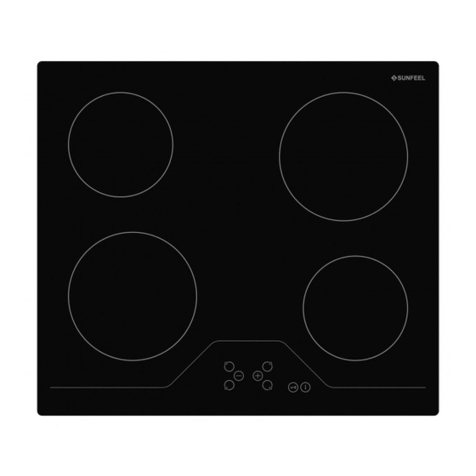
SUNFEEL
SUNFEEL PLV4FBT Operating and installation instructions

Miele
Miele KM 5941 Operating and installation instructions

Electrolux
Electrolux CIV63344 user manual


